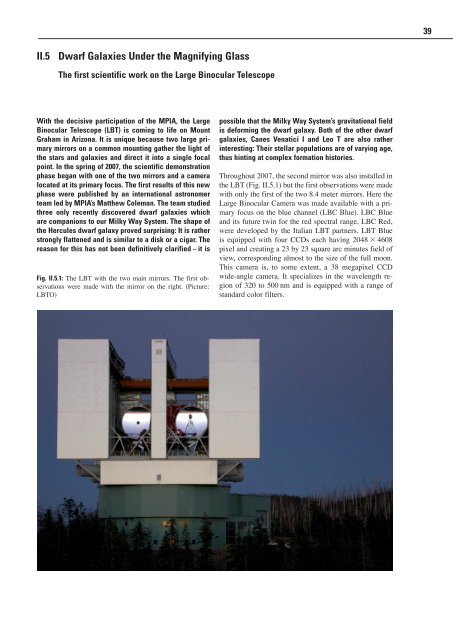Max Planck Institute for Astronomy - Annual Report 2007
Max Planck Institute for Astronomy - Annual Report 2007
Max Planck Institute for Astronomy - Annual Report 2007
Create successful ePaper yourself
Turn your PDF publications into a flip-book with our unique Google optimized e-Paper software.
II.5 Dwarf Galaxies Under the Magnifying Glass<br />
The first scientific work on the Large Binocular Telescope<br />
With the decisive participation of the MPIA, the Large<br />
Binocular Telescope (LBT) is coming to life on Mount<br />
Graham in Arizona. It is unique because two large primary<br />
mirrors on a common mounting gather the light of<br />
the stars and galaxies and direct it into a single focal<br />
point. In the spring of <strong>2007</strong>, the scientific demonstration<br />
phase began with one of the two mirrors and a camera<br />
located at its primary focus. The first results of this new<br />
phase were published by an international astronomer<br />
team led by MPIA’s Matthew Coleman. The team studied<br />
three only recently discovered dwarf galaxies which<br />
are companions to our Milky Way System. The shape of<br />
the Hercules dwarf galaxy proved surprising: It is rather<br />
strongly flattened and is similar to a disk or a cigar. The<br />
reason <strong>for</strong> this has not been definitively clarified – it is<br />
Fig. II.5.1: The LBT with the two main mirrors. The first observations<br />
were made with the mirror on the right. (Picture:<br />
LBTO)<br />
possible that the Milky Way System’s gravitational field<br />
is de<strong>for</strong>ming the dwarf galaxy. Both of the other dwarf<br />
galaxies, Canes Venatici I and Leo T are also rather<br />
interesting: Their stellar populations are of varying age,<br />
thus hinting at complex <strong>for</strong>mation histories.<br />
Throughout <strong>2007</strong>, the second mirror was also installed in<br />
the LBT (Fig. II.5.1) but the first observations were made<br />
with only the first of the two 8.4 meter mirrors. Here the<br />
Large Binocular Camera was made available with a primary<br />
focus on the blue channel (LBC Blue). LBC Blue<br />
and its future twin <strong>for</strong> the red spectral range, LBC Red,<br />
were developed by the Italian LBT partners. LBT Blue<br />
is equipped with four CCDs each having 2048 3 4608<br />
pixel and creating a 23 by 23 square arc minutes field of<br />
view, corresponding almost to the size of the full moon.<br />
This camera is, to some extent, a 38 megapixel CCD<br />
wide-angle camera. It specializes in the wavelength region<br />
of 320 to 500 nm and is equipped with a range of<br />
standard color filters.<br />
39

















